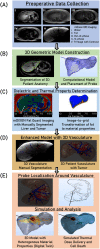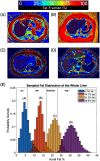Simulation of Image-Guided Microwave Ablation Therapy Using a Digital Twin Computational Model
- PMID: 38445239
- PMCID: PMC10914207
- DOI: 10.1109/OJEMB.2023.3345733
Simulation of Image-Guided Microwave Ablation Therapy Using a Digital Twin Computational Model
Abstract
Emerging computational tools such as healthcare digital twin modeling are enabling the creation of patient-specific surgical planning, including microwave ablation to treat primary and secondary liver cancers. Healthcare digital twins (DTs) are anatomically one-to-one biophysical models constructed from structural, functional, and biomarker-based imaging data to simulate patient-specific therapies and guide clinical decision-making. In microwave ablation (MWA), tissue-specific factors including tissue perfusion, hepatic steatosis, and fibrosis affect therapeutic extent, but current thermal dosing guidelines do not account for these parameters. This study establishes an MR imaging framework to construct three-dimensional biophysical digital twins to predict ablation delivery in livers with 5 levels of fat content in the presence of a tumor. Four microwave antenna placement strategies were considered, and simulated microwave ablations were then performed using 915 MHz and 2450 MHz antennae in Tumor Naïve DTs (control), and Tumor Informed DTs at five grades of steatosis. Across the range of fatty liver steatosis grades, fat content was found to significantly increase ablation volumes by approximately 29-l42% in the Tumor Naïve and 55-60% in the Tumor Informed DTs in 915 MHz and 2450 MHz antenna simulations. The presence of tumor did not significantly affect ablation volumes within the same steatosis grade in 915 MHz simulations, but did significantly increase ablation volumes within mild-, moderate-, and high-fat steatosis grades in 2450 MHz simulations. An analysis of signed distance to agreement for placement strategies suggests that accounting for patient-specific tumor tissue properties significantly impacts ablation forecasting for the preoperative evaluation of ablation zone coverage.
Keywords: Computational model; digital twin; fatty liver disease; finite element; liver cancer; microwave ablation.
© 2023 The Authors.
Figures











